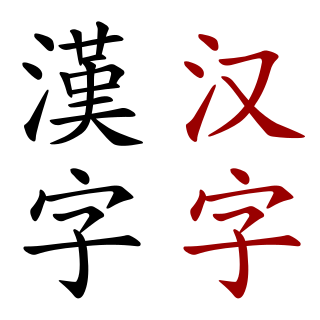
The Zhuang people are an ethnic group who mostly live in the Guangxi Zhuang Autonomous Region in southern China. Some also live in the Yunnan, Guangdong, Guizhou and Hunan provinces. They form one of the 56 ethnic groups officially recognized by the People's Republic of China. With the Buyi, Tay–Nùng, and other northern Tai speakers, they are sometimes known as the Rau or Rao. Their population, estimated at 18 million people, makes them the largest minority in China.

The languages of China are the languages that are spoken in China. The predominant language in China, which is divided into seven major language groups, is known as Hanyu and its study is considered a distinct academic discipline in China. Hanyu, or Han language, spans eight primary varieties, that differ from each other morphologically and phonetically to such a degree that they will often be mutually unintelligible, similarly to English and German or Danish. The languages most studied and supported by the state include Chinese, Mongolian, Tibetan, Uyghur and Zhuang. China has 299 living languages listed at Ethnologue. According to the 2010 edition of the Nationalencyklopedin, 955 million out of China's then-population of 1.34 billion spoke some variety of Mandarin Chinese as their first language, accounting for 71% of the country's population.

The Zhuang languages are any of more than a dozen Tai languages spoken by the Zhuang people of southern China in the province of Guangxi and adjacent parts of Yunnan and Guangdong. The Zhuang languages do not form a monophyletic linguistic unit, as northern and southern Zhuang languages are more closely related to other Tai languages than to each other. Northern Zhuang languages form a dialect continuum with Northern Tai varieties across the provincial border in Guizhou, which are designated as Bouyei, whereas Southern Zhuang languages form another dialect continuum with Central Tai varieties such as Nung, Tay and Caolan in Vietnam. Standard Zhuang is based on the northern Zhuang dialect of Wuming.

Old Chinese, also called Archaic Chinese in older works, is the oldest attested stage of Chinese, and the ancestor of all modern varieties of Chinese. The earliest examples of Chinese are divinatory inscriptions on oracle bones from around 1250 BC, in the late Shang dynasty. Bronze inscriptions became plentiful during the following Zhou dynasty. The latter part of the Zhou period saw a flowering of literature, including classical works such as the Analects, the Mencius, and the Zuo zhuan. These works served as models for Literary Chinese, which remained the written standard until the early twentieth century, thus preserving the vocabulary and grammar of late Old Chinese.

The Book of Documents or Classic of History, also known as the Shangshu, is one of the Five Classics of ancient Chinese literature. It is a collection of rhetorical prose attributed to figures of ancient China, and served as the foundation of Chinese political philosophy for over 2,000 years.
Tai Nuea is one of the languages spoken by the Dai people in China, especially in the Dehong Dai and Jingpo Autonomous Prefecture in the southwest of Yunnan province. It is closely related to the other Tai languages. Speakers of this language across the border in Myanmar are known as Shan. It should not be confused with Tai Lü. There are also Tai Nuea speakers in Thailand.

The Tai Le script, or Dehong Dai script, is a script used to write the Tai Nüa language of south-central Yunnan, China. It is written in horizontal lines from left to right, with spaces only between clauses and sentences.
Naxi, also known as Nakhi, Nasi, Lomi, Moso, Mo-su, is a Sino-Tibetan language or group of languages spoken by some 310,000 people most of whom live in or around Lijiang City Yulong Naxi Autonomous County of the province of Yunnan, China. Nakhi is also the ethnic group that speaks it, although in detail, officially defined ethnicity and linguistic reality do not coincide neatly: there are speakers of Naxi who are not registered as "Naxi", and citizens who are officially "Naxi" but do not speak it.
The Bai language is a language spoken in China, primarily in Yunnan province, by the Bai people. The language has over a million speakers and is divided into three or four main dialects. Bai syllables are always open, with a rich set of vowels and eight tones. The tones are divided into two groups with modal and non-modal phonation. There is a small amount of traditional literature written with Chinese characters, Bowen (僰文), as well as a number of recent publications printed with a recently standardized system of romanisation using the Latin alphabet.

The Chinese Tatars form one of the 56 ethnic groups officially recognized by the People's Republic of China.
The Romanization of Chinese is the use of the Latin alphabet to write Chinese. Chinese uses a logographic script, and its characters do not represent phonemes directly. There have been many systems using Roman characters to represent Chinese throughout history. Linguist Daniel Kane recalls, "It used to be said that sinologists had to be like musicians, who might compose in one key and readily transcribe into other keys." The dominant international standard for Putonghua since about 1982 has been Hanyu Pinyin. Other well-known systems include Wade-Giles (Mandarin) and Yale Romanization.
The Sui language is a Kam–Sui language spoken by the Sui people of Guizhou province in China. According to Ethnologue, it was spoken by around 200,000 people in 1999. Sui is also unique for its rich inventory of consonants, with the Sandong (三洞) dialect having as many as 70 consonants. The language also has its own script, known as "Shuishu" (水書) in Chinese, which is used for ritual purposes.

The Uyghur Perso-Arabic alphabet is an Arabic alphabet used for writing the Uyghur language, primarily by Uyghurs living in China. It is one of several Uyghur alphabets and has been the official alphabet of the Uyghur language since 1982.

The Chinese family of scripts are writing systems descended from the Chinese Oracle Bone Script and used for a variety of languages in East Asia. They include logosyllabic systems such as the Chinese script itself, and adaptations to other languages, such as Kanji (Japanese), Hanja (Korean), Chữ nôm (Vietnamese) and sawndip (Zhuang). More divergent are Tangut, Khitan large script, and its offspring Jurchen, as well as the Yi script and possibly Korean Hangul, which were inspired by Chinese although not directly descended from it. The partially deciphered Khitan small script may be another. In addition, various phonetic scripts descend from Chinese characters, of which the best known are the various kana syllabaries, the zhuyin semi-syllabary, nüshu, and some influence on hangul.

Zhou Youguang was a Chinese economist, banker, linguist, sinologist, publisher, and supercentenarian, known as the "father of Pinyin", a system for the writing of Mandarin Chinese in Roman script, or romanization, which was officially adopted by the government of the People's Republic of China in 1958, the International Organization for Standardization (ISO) in 1982, and the United Nations in 1986.
William Hubbard Baxter III is an American linguist specializing in the history of the Chinese language and best known for his work on the reconstruction on Old Chinese.

Standard Zhuang is the official standardized form of the Zhuang languages, which are a branch of the Northern Tai languages. Its pronunciation is based on that of the Yongbei Zhuang dialect of Shuangqiao, Guangxi in Wuming District, Guangxi with some influence from Fuliang, also in Wuming District, while its vocabulary is based mainly on northern dialects. The official standard covers both spoken and written Zhuang. It is the national standard of the Zhuang languages, though in Yunnan a local standard is used.
In the People's Republic of China, the government had instated affirmative action policies for ethnic minorities called Youhui zhengce or Shaoshu minzu jiafen when it began in 1949 and still had impact until today. The policies giving preferential treatment to ethnic minorities in China. For example, Minority ethnic groups in China are not subjected to its well-publicized One-child policy. Three principles are the basis for the policy: equality for national minorities, territorial autonomy, and equality for all languages and cultures.
Nicholas Cleaveland Bodman was an American linguist who made fundamental contributions to the study of historical Chinese phonology and Sino-Tibetan languages.
















